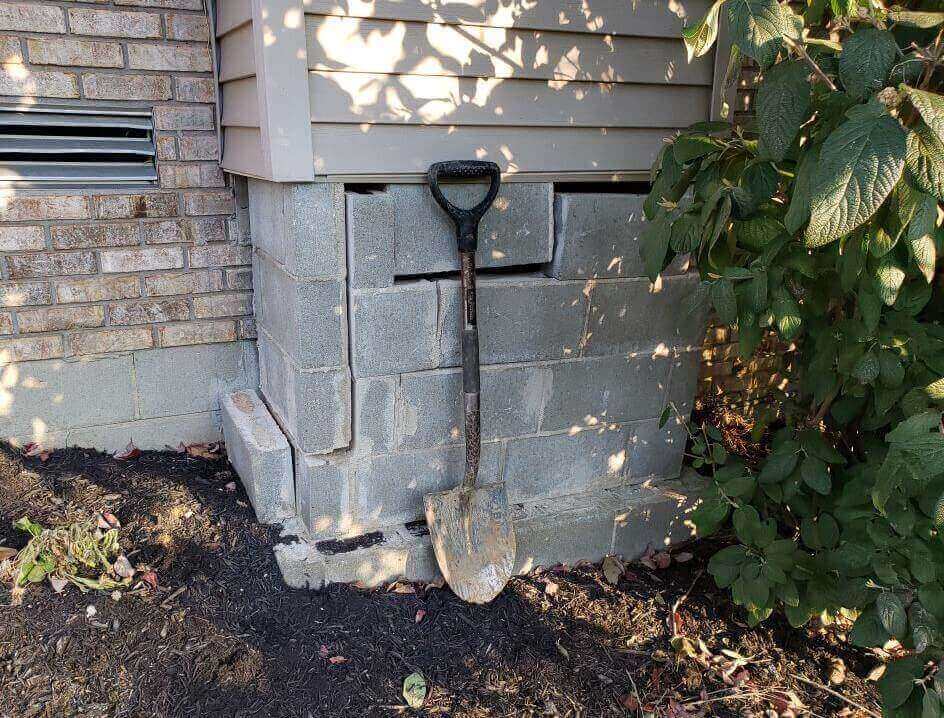
It depends. Yes, that’s a terrible answer. No one likes it. I don’t like writing it. But it’s accurate, because ‘foundation repair’ is a very broad term. Multiple issues and their corresponding repair methods fall under that heading, so your results may vary (another tired and tedious marketing phrase).
I’m starting to feel like I’m writing that fine print that someone reads extra-super-fast at the end of a pharmaceutical commercial. And that is not what I’m here to do. I want to provide helpful, sensible, genuinely useful information. I bet that’s also what you’re looking for. So let’s get away from this generic nonsense and dig into the specific details you want.
Acculevel is a foundation and waterproofing company that began in 1996. We are family-owned and operated, and proudly stand by our products and services. We provide the best warranties in the industry, and believe that all homeowners should be worked with in a fair, honest and transparent manner.
In this article, we’ll explain the major types of foundation repairs, the repair methods, and how long you should expect these repairs to last. We’ll also include additional references you can check out, if you have additional questions about any of the problems or their solutions.
If you have small or hairline cracks in your foundation, you should have them professionally reviewed. There are many reasons a crack may develop; some of them are natural and relatively minor. But they can be a sign of more significant problems, and that’s why we encourage you to get a formal evaluation.
If these cracks are not too large or severe, the best repair method is an epoxy fill. However, if water intrusion is present, a more comprehensive solution like foundation leak repair may be necessary to prevent further damage. You should expect a quality epoxy crack repair to last at least 5 years.
You can find more information about cracks and their causes here, and why Acculevel recommends epoxy fill in this blog.
All photos were taken by Acculevel project managers during free routine estimates.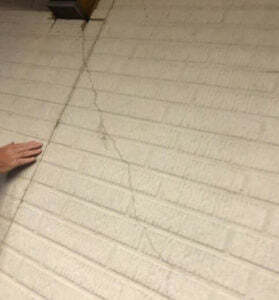 This hairline crack has started to widen, allowing water to intrude. (FYI: this wall is poured concrete with a brick facade.)
This hairline crack has started to widen, allowing water to intrude. (FYI: this wall is poured concrete with a brick facade.)
If your foundation cracks are more substantial, like a long horizontal crack or a stair-step shaped-crack, these are signs that your wall is on its way to bowing or buckling. You should have this professional repaired, and quickly. If your wall is already beginning to bow, take action immediately. Bowing walls are walls that can -and will- eventually collapse. It is far less expensive to repair a wall before it collapses!
The type of repair you need for a cracked or bowing wall varies; the extent of the damage is the deciding factor. Walls that are only cracked or bowing less than 2 inches can be repaired with carbon fiber straps.
 This wall has both long horizontal and stair-step cracks.
This wall has both long horizontal and stair-step cracks.
If the wall is bowing more than 2 inches, you’ll need either wall anchors or helical tiebacks. In this situation, it’s your property that determines which repair type is best. Wall anchors require at least 10 feet of usable land, outside the damaged wall. If this crosses your property line or will intersect with your septic system (or pool, garage, etc.) tiebacks are a better fit.
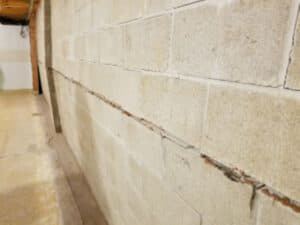 This began with a long horizontal crack. As the crack widened, the wall began bowing inward.
This began with a long horizontal crack. As the crack widened, the wall began bowing inward.
Regardless of method, repairs to a bowing wall made by an experienced contractor should last for an extended period of time. Acculevel warranties their repairs for the life of the structure.
Do you think carbon fiber straps are what you need? This blog provides details about straps and their costs. For the same information about anchors or tiebacks, this article breaks down the installation process and costs.
There are specific symptoms that can indicate a foundation is settling, and you may have some or all of them:
If your foundation is settling, the best repair method is helical piers. Other contractors may use push piers, but Acculevel prefers to use helical piers. Over the years, we’ve seen push piers cause unnecessary stress or damage to residential buildings. Helical piers do not come with the same degree of risk, largely because they do not rely on the weight of the building to force the piers into the earth. We have an article that compares the two pier methods side-by-side, if you would like more information.
Like bowing wall repairs, Acculevel warranties their pier installations for the life of your structure.
This blog discusses helical piers, explains how they’re installed, and provides pricing information.
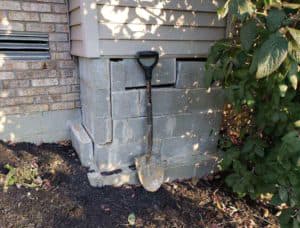 This chimney has settled unevenly, allowing the blocks to come loose.
This chimney has settled unevenly, allowing the blocks to come loose.
After piers: the chimney foundation is stable and secure. 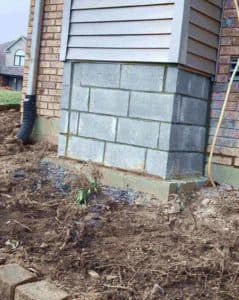 (This photo was taken by an Acculevel team member after installation.)
(This photo was taken by an Acculevel team member after installation.)
Are you familiar with the true definition of “lifetime warranty?” We’ve researched the laws that govern these, and I bet you’d be surprised- and not in a good way -by how flexible the definition is. You can read our findings in this blog.
Not sure how to hire the right contractor for you? We’ve compiled the Questions You Should Ask a Contractor, complete with a downloadable form for you to use.
If you have seen indications of foundation problems, but you’re not sure how to interpret them, we have a free tool you can use. Identify problems, explore solutions, and get advice on how and when to take action with our Symptom Checker.
Find an experienced local foundation company, and make an appointment. Before you sign a contract for any service, you should always verify the company is reputable, insured, and accredited by the Better Business Bureau.
If you're looking for foundation repair in Cedar Rapids, IA, Indiana or the surrounding areas, contact Acculevel. We provide free estimates in writing that are valid for 12 months. One of our experienced project managers will evaluate your home and recommend the best course of action to keep your home safe and healthy for years to come.
[DISPLAY_ULTIMATE_SOCIAL_ICONS]